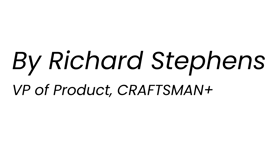Introducing Craft Class: Stories of Creativity and Innovation
Welcome to "Craft Class," a new series where we spotlight the brilliant minds behind CRAFTSMAN+, their journeys, challenges, and the innovative solutions they bring to the digital creative space. This month, we're featuring Richard Stephens, VP of Product, who plays a pivotal role in steering CRAFTSMAN+’s product development towards excellence. Read his insights on building CANVAS and PLAY, the importance of iterative development, and the collaborative spirit that drives CRAFTSMAN+.


When making products that push the bounds of what’s available on the market, it can often feel like you and your team are walking across a bridge as you build it. This has been my experience over the last two years building both our new static ad creation platform, CANVAS, and our playable builder, PLAY.
As part of CRAFTSMAN+’s commitment to empowering creativity, both CANVAS and PLAY underwent extensive internal testing to meet the needs of both experienced designers and marketers just starting out. Our goal was to build a product that provided value to every member of a marketing team. After some trial and error, what we built are two simple yet powerful platforms that automate creative optimization and scale the design process, so that brands can focus on what truly matters: storytelling.
Here’s how we built them.
Building the Bridge as We Walked it: The Importance of Feedback
One of our key advantages at CRAFTSMAN+ is that we are both a creative agency and technology company. This means that our design expertise is baked into the products that we build. As a product team, we’re lucky that we have a pool of ideal users — e.g. our own designers — that we can speak to about our products, their UI and features. Their insights alongside market feedback from our customers were essential in building CANVAS and PLAY.
Specifically, for CANVAS, after 6 months, we were able to build a first iteration of the platform for our design team to try. This alpha testing allowed us to do a lot of the heavy lifting before our customers and the wider market had access to it.
Of course, this wasn’t without its challenges. It took us about a year to rebuild the entire UI and flow based on feedback from our own design team. The truth is, we kept maybe 30% of the original concept and rebuilt the rest over the course of 2023.
The Power of Prototypes
What we learned from this experience was the importance of prototypes. There’s a massive gap between a flat design and thinking about a product’s flow in theory and a 3D design accounting for interactions in actual practice. Compound that with timelines and the need to build something fast — in the end, we overlooked some practical design needs in the name of efficiency. My takeaway from this misstep is the importance of building prototypes for any project that’s going to take longer than a month’s work.
Also, the more time you can spend getting meaningful feedback from users before you commit to coding the design, the better. Even if it feels like it’s taking more up front time and resources, it pays off in the end.
Sprinting Our Way to Success
Like many technology companies, we use 2-week sprints to help us carve big projects into meaningful chunks of work, and ensure continuous improvement and adaptability. They also help us more accurately track the time it will take to finish bigger builds.
But, we’ve found that within the sprint format, there can be challenges. For example, our team only had an average 50% sprint completion rate. To solve this we started doing our daily stand up meetings differently. We focused more on individuals’ ownership of the work committed to a sprint and used our daily sync to find opportunities where we could support each other as a team — like a team huddle during the half time of a big game.
This helped us better manage our timelines and lessen the impact of delays when bugs came up since everyday we were checking in with each other and managing shifts. By boosting our team’s communication with daily stand up meetings, we increased our sprint completion rate to 92%!
When Working Remotely, Communication is (More) Key
Ideally, our team would work together in person. In my opinion, this drives spontaneous communication and ideation that can fuel innovation and problem-solving. But, that’s not our reality and we’ve been able to recruit a brilliant product team because of our ability to work remotely across the globe.
The way we’ve overcome the challenge of working remotely is by fostering a culture of open communication. I encourage our team members to break down barriers virtually by sending frequent Slack messages and scheduling impromptu meetings. I always tell my team to communicate like they’re in an office together: ask for advice, share knowledge spontaneously, send a funny meme — it’s important not to silo yourself off.
To Be Innovative, Listen to Innovators
My advice to any company operating in a fast-paced industry like digital advertising is to listen to customer feedback but emphasize the feedback of certain customers. We’ve found the most insightful information comes from customers who are at the top edge of the market — who are pushing the boundaries of advertising and storytelling with innovative technology and solutions. By listening to each other, we can help push the whole market forward. Yes, the customer is always right but it’s also smart to identify when your unique expertise can actually help bring a customer up in the marketplace.
Crafting the Future with CANVAS
I’m very proud of our team for building PLAY and CANVAS, which seek to bridge the gap between power and accessibility in creative design tools. By balancing advanced functionality with intuitive design, we've created tools that empower both designers and marketers.
Join Us on Our Journey of Innovation
As we continue to explore and expand the horizons of digital creativity, we invite you to be a part of our journey. Whether through CANVAS or PLAY, our suite of creative technology tools can help you connect with your audience. Let's create, innovate, and inspire together.

.png?width=300&name=2000x800_CraftClass_BlogHeader%20(3).png)